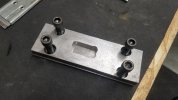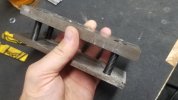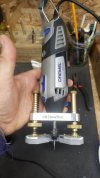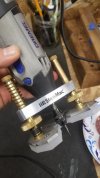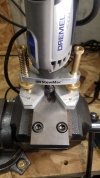- Joined
- Sep 27, 2004
- Messages
- 3,041
Hey,
I've finally acquired some of the nice shield parsher plates and shields from leading edge fabrications and they are super high quality and crisp.
I now realize I'm not 100% sure how to get a perfect cut with these. I have a milling machine and a dremel to use. The plates are 1075 annealed.
Initially I envisioned running some kind of cutter along the inside. Do I need to harden these plates or are people using some kind of endmill/cutter that has a smooth edge the same OD as the cutter with some kind of shallow bit?
The only way I could envision it would be to use something like a 1/32 or 1/16 endmill, after fully hardening the plate and then just running the cutter into the plate itself around the edge and letting it dull or throwing it away after each shield. I'd avoid carbide so as to not actually cut the plate.
Once I did that, it seems I could just set a depth on my mill, drop it onto the handle material with the plate fixed to it in some way and move the handle around under it?
Just wanting to also confirm what endmills other are using. 1/16 looks like it may work but for shapes that have sharp corners a 1/32 might be better?
If anyone has pics of the setup they are using that would be great.
I've finally acquired some of the nice shield parsher plates and shields from leading edge fabrications and they are super high quality and crisp.
I now realize I'm not 100% sure how to get a perfect cut with these. I have a milling machine and a dremel to use. The plates are 1075 annealed.
Initially I envisioned running some kind of cutter along the inside. Do I need to harden these plates or are people using some kind of endmill/cutter that has a smooth edge the same OD as the cutter with some kind of shallow bit?
The only way I could envision it would be to use something like a 1/32 or 1/16 endmill, after fully hardening the plate and then just running the cutter into the plate itself around the edge and letting it dull or throwing it away after each shield. I'd avoid carbide so as to not actually cut the plate.
Once I did that, it seems I could just set a depth on my mill, drop it onto the handle material with the plate fixed to it in some way and move the handle around under it?
Just wanting to also confirm what endmills other are using. 1/16 looks like it may work but for shapes that have sharp corners a 1/32 might be better?
If anyone has pics of the setup they are using that would be great.

